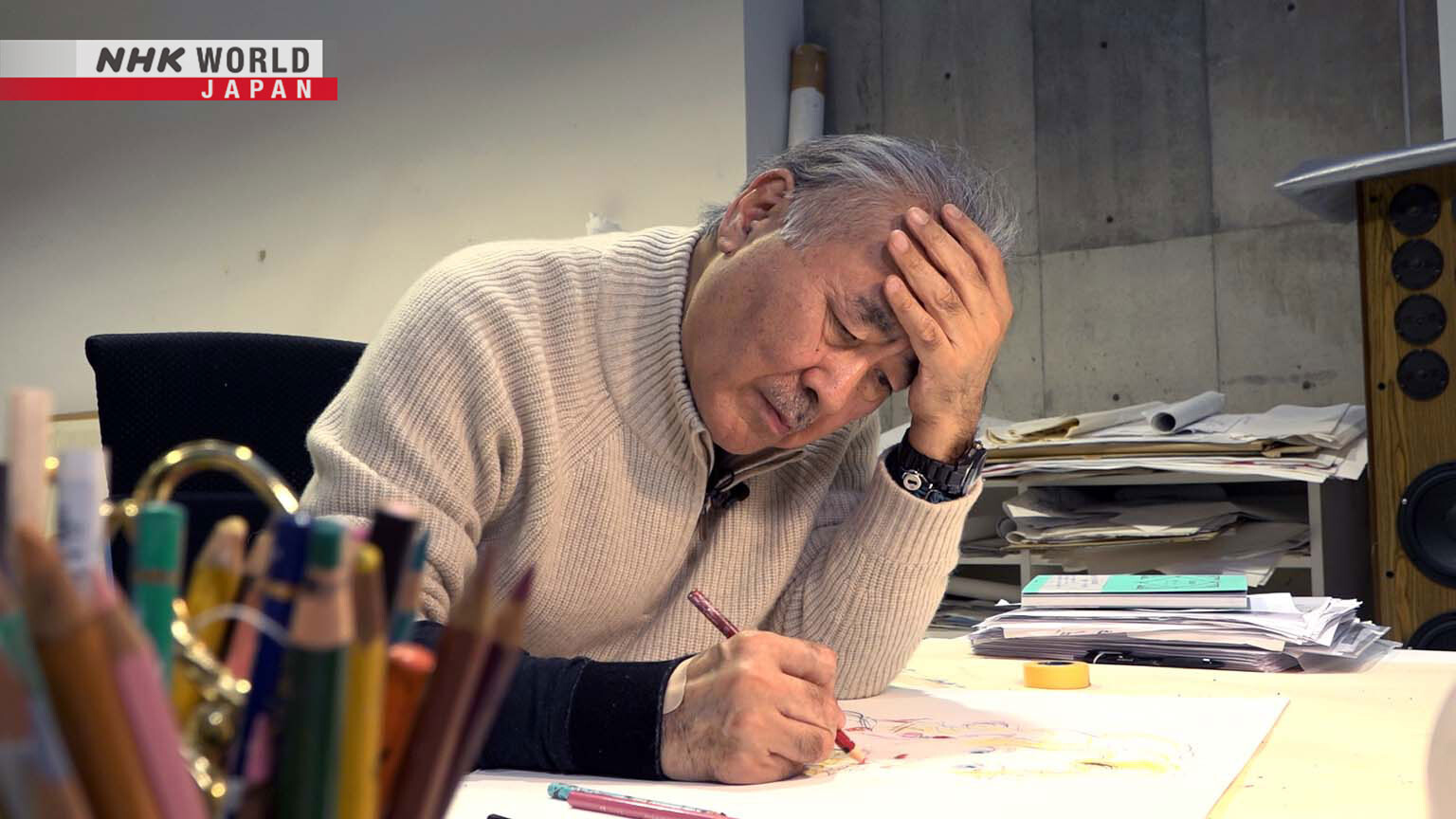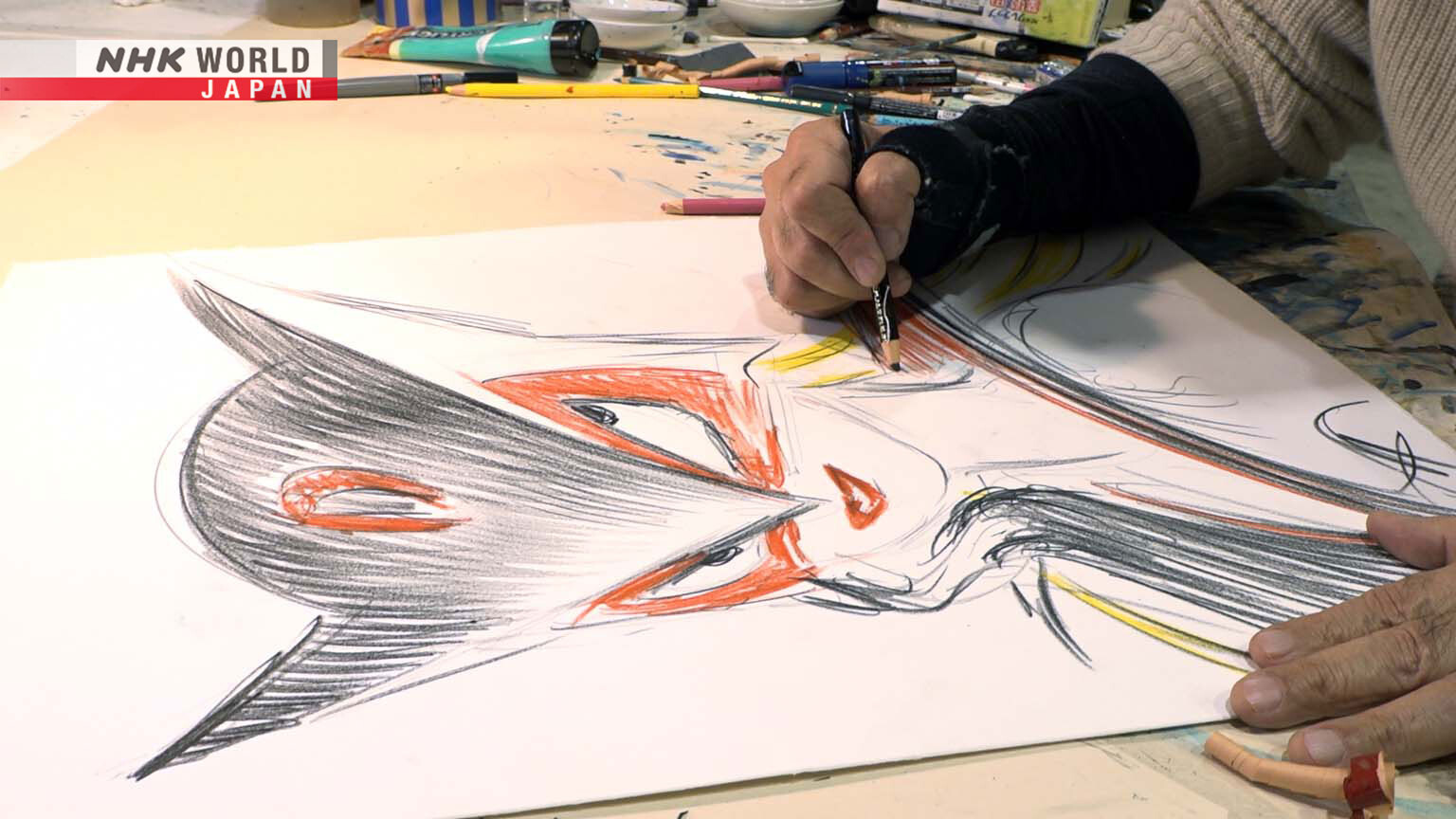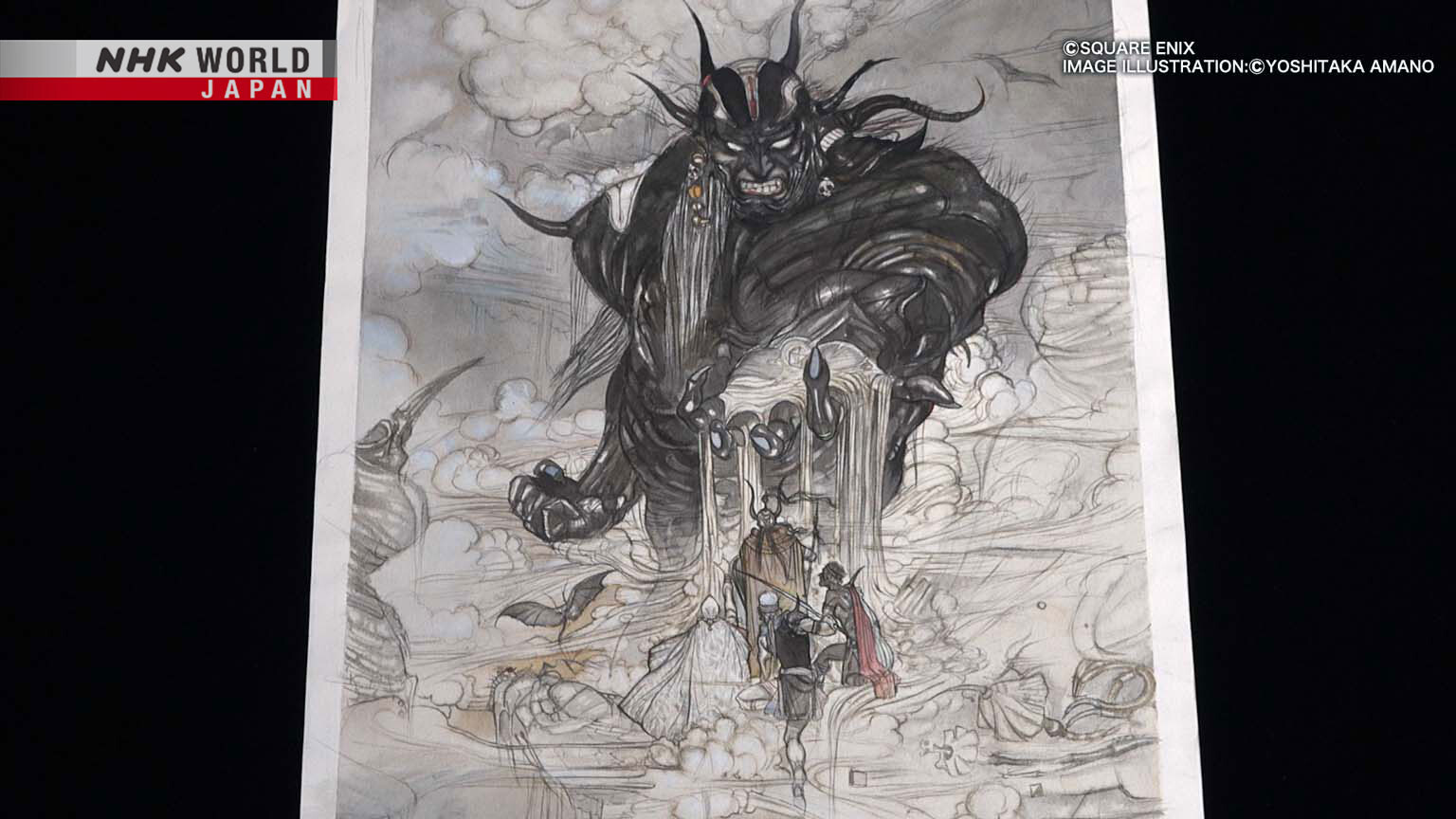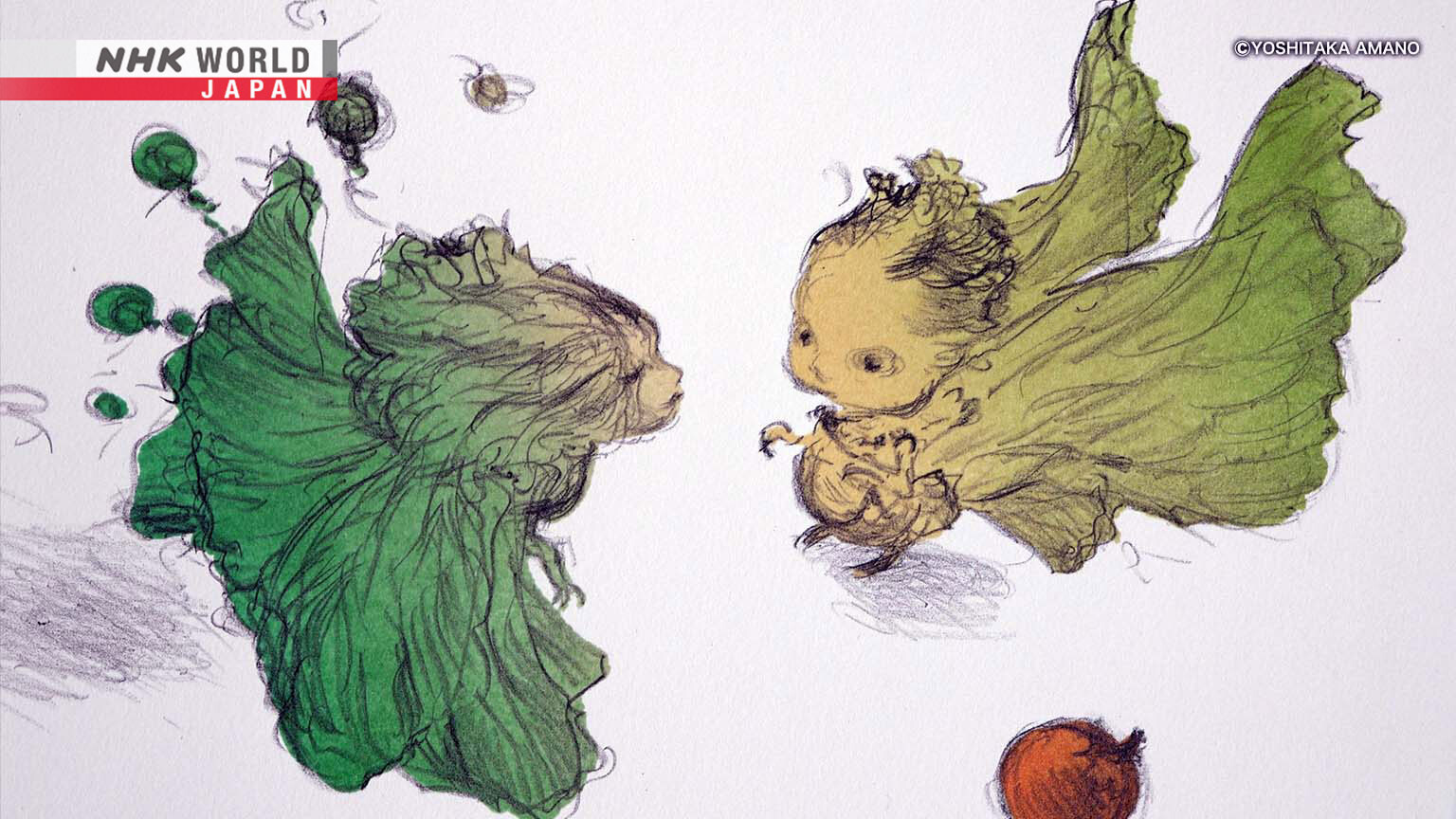Legendary Creator Amano Yoshitaka
ANIME MANGA EXPLOSION dives into the world of Japanese anime and manga, both of which have gained immense global followings. This time, we feature artist and character designer Amano Yoshitaka. With a career that spans decades, Amano created some of Japan's most iconic anime characters, including Yatterman and Casshan. Amano was also instrumental in shaping the world of FINAL FANTASY, one of the most beloved game series of all time with 37 years of history. Now, at 72, Amano shows no signs of slowing down. Watch and discover what keeps his creative spark as bright as ever.




Transcript
ANIME MANGA EXPLOSION
Today, we're featuring a legendary creator who continues to make art in his spacious Tokyo studio.
Artist and character designer, Amano Yoshitaka.
Now 72 years old, Amano has been working as a professional artist for 57 years.
It's fascinating how tools can shape your artistic approach.
The way of expression changes depending on the tool.
They influence the worlds I create.
Amano began his career as a teenager designing anime characters.
In the 1970s, he designed characters for a wide variety of genres, including comedy and stylish sci-fi.
From the 80s on, Amano became active as an illustrator.
He is famous for designing characters and creating the concept art for the "FINAL FANTASY" video game series.
For 37 years, Amano's art has defined the worldview of one of the most popular video game series.
Everything starts with character design.
The characters shape the narrative, becoming the heart and soul of a story.
Now, let's dive into the mesmerizing world of Amano Yoshitaka and his fascinating creations!
- This one.
- Thank you.
No problem.
Amano gave us a special look into his character design process.
How about a stylish male hero?
There are all kinds of heroes.
Amano moves his pencil across the page with no hesitation.
Roles are important. What's the character's role?
How old? What kind of hairstyle? What color hair?
Almost instantly, Amano has created a hero looking back at us with resolution.
Let's go a bit darker.
Even with the same character design,
tweaking the hairstyle can completely change the tone
and create a more ambiguous or neutral character.
By adjusting hairstyle and angle of the face, Amano gives the hero completely different aura.
Next, Amano began drawing one of his past characters.
Doronjo is all black. It takes a lot of work.
In just 10 minutes, Amano was finished drawing a character he created over 47 years ago.
I'll never forget Doronjo. It all started from my imagination.
An older sister with a mature charm. That was my goal.
Amano began his career in 1967 when he was 15.
He made the decision after touring a popular anime studio.
Tatsunoko Production, a pioneering studio that was pushing the boundaries of animation.
I thought I might as well bring some drawings.
I don't remember, but apparently, I said, "I want to join this studio!"
Soon after, I was hired.
Amano's talent was quickly recognized.
He joined Tatsunoko Production at 16.
He quickly made his mark as an animator and rose to the position of animation director in just four years.
One person took special notice of Amano's ability.
The founder of Tatsunoko Production, Yoshida Tatsuo.
Yoshida was a leader in all aspects of the company,
from business to product planning and screenwriting.
Yoshida was renowned for his ability to create realistic humans, and he designed many Tatsunoko characters.
Yoshida held Amano's work in high regard and promoted him to character designer at just 20 years old.
Yoshida was one of my heroes.
If he told me to do something, I would give it all I had.
He really liked me and gave me many opportunities.
At the time, Tatsunoko Production's focus was on creating original anime from scratch.
Yoshida and his colleagues would stay together at a retreat to work on character designs.
We would stay at a ryokan and come up with new ideas.
We worked from morning till night drawing on a large low table.
The best images were chosen.
In a way, we were all artistic rivals.
If I made something producers liked, colleagues got jealous.
Only the images that fit the work best were chosen.
Amano proved his worth and ended up working with Yoshida on main character designs.
I'm Casshan!
This character is from a sci-fi anime by Yoshida.
"Casshan" was broadcast on TV in 1973.
The story follows Casshan,
a man who gave up his human body to become machine and fight for humanity.
The simple yet stylish designs caused a lot of buzz.
Casshan is the perfect embodiment of "less is more."
The design is sleek without redundancies.
No belt made it difficult for animators.
It's all about design, not logic.
Amano's creativity led to the birth of even more popular characters in 1977.
The victory pose!
Yatta! Yatta! Yatterman!
Part of the "Time Bokan Series,"
"Yatterman" is a comedic anime where Yatterman and the Doronbow crew face off in search of various treasures.
The Doronbow villains eventually eclipsed the popularity of the heroes.
The hard-to-hate characters became a major part of the story.
- I'm lucky to have such a team.
- We're lucky to have such a wonderful boss!
Amano's ingenuity to make his characters stand out can be found in their designs.
It's all balance. It needs to be a balanced shape.
That could mean the silhouette, the character's presence,
or their role in the story.
Take their physique, for example...
As he answered our questions, Amano began to draw three different characters.
This is a square. Shapes like this.
The hands should be bigger for balance. Same with the feet.
This one, too.
The muscular Tonzra has a blocky build.
The brainy Boyacky is slender with a big nose.
Their female boss, Doronjo, has a curvy silhouette.
Amano used deformation to emphasize their differences while maintaining balanced silhouettes.
Even far away, you can differentiate between a giraffe and an elephant.
Being able to tell characters apart from a distance is key.
Amano's character designs stand out regardless of speed or movement.
When "Yatterman" began to air in 1977, Amano's mentor, Yoshida Tatsuo, passed away.
Amano was 25 years old.
We talked to someone who knew both Amano and Yoshida personally.
Anime director Sasagawa Hiroshi worked directly with Yoshida and Amano.
Sasagawa is known for directing Tatsunoko Production hits like the "Time Bokan Series" and "Casshan."
He told us about some things Yoshida shared with him.
He told me to make sure that Amano doesn't copy his style.
Yoshida found Amano's work so appealing.
He could tell Amano had something he lacked.
After Yoshida's passing, Amano continued to create characters in his own unique style.
- I wonder how long it's been since we left Earth.
- About a week?
The sci-fi horror anime "Exception" aired in 2022.
The story follows the genetically engineered crew of a spaceship.
Amano was in charge of designing characters.
He went with designs that you might find in a fashion magazine.
The imagery far surpassed director YUZO's expectations.
I originally imagined a space suit that felt like a futuristic NASA outfit.
Amano's designs completely surpassed my imagination.
I view his work as art instead of just anime characters.
The final designs gave me goosebumps. They felt new yet universal.
Amano, who grew up watching Yoshida work, has a firm stance about character designs.
I don't reference other artists' work.
It's more interesting to create things that haven't existed in anime before.
At Tatsunoko Production, Amano built a successful career as a character designer.
But at 25, Amano realized he had an unbalanced skillset.
Art created by character designers isn't directly featured.
Animators make the character for the anime.
I wondered what my art would look like, but didn't know how to start.
I knew how to draw but not how to make art.
As a character designer, Amano dedicated much of his time to researching,
but never took the time to study art.
He eventually began to search for his own artistic style.
Amano did a deep dive into Western art he has always liked, such as Mucha and Klimt.
I did a lot of copying. I never used paints or pens before.
I had only used pencils. I started from there.
Amano went to publishers to sell his illustrations.
Gradually, the industry began recognizing his abilities, and job offers poured in.
In 1982, 30-year-old Amano left Tatsunoko Production to focus all his energy on illustration work.
The majority of jobs were for fantasy novel covers and illustrations.
I got ideas from reading the novels.
For me, fantasy was such a liberating genre.
And at 31, Amano finally created a work he was proud to call his own.
I drew the protagonist, a beautiful boy, in my own way.
It felt surprisingly unique to me. Especially the eyes.
That was a turning point for me.
Amano became famous as the illustrator for one of the most popular fantasy series at the time.
One day, a brand-new type of job offer came in.
It was to design characters for an upcoming video game with a lot of effort being put into production.
The title was "FINAL FANTASY."
The role-playing game had players embark on an adventure to save the world.
This was Amano's first time to work with video games, but he made it his own.
"FINAL FANTASY" went on to become an international hit,
with Amano designing characters up until "FINAL FANTASY VI."
I never connected video games and fantasy.
But since it was fantasy, I knew I could do it.
We got a look at some materials from the time.
This is a list of monsters the game maker gave Amano.
It contains the monster's name and a short description.
For example, the description for the monster Behemoth reads:
A gigantic four-legged beast.
Its skin is grey and thick.
The end of its thick tail is swollen and is sprouting thorns.
This is what Amano created.
Amano took the order and created a muscular monster full of rage.
One other was a parasite that sucks out magic abilities from the human brain.
This is what Amano came up with.
Amano designs all of his monsters to be in action poses.
His experience in anime production is what led to this process.
In the game, the monsters will be much smaller.
They need unique shapes and silhouettes for personality.
Game consoles were just 8-bit at the time,
so there was a limit to the number of dots each design could use.
Instead of focusing on details, he created silhouettes full of personality.
Art directors took Amano's designs and put them into the game.
Shibuya Kazuko has been with "FINAL FANTASY" since the very beginning, creating pixel art for the entire series.
Shibuya recreated Amano's monsters in the game using the limited amount of colors and dots available.
Small monsters used three colors. Boss types used five.
Amano's poses contain a lot of space.
I try my best to express the sense of movement in his lines.
Like giving the fringes a fluttering feel.
When game players look at the tiny pixel art,
I want them to imagine Amano's art in their mind.
Amano also influenced the overall concept of the "FINAL FANTASY" series.
He stores art for the game in the basement of his studio.
This is from "FINAL FANTASY."
It was the first drawing I did for the series.
The order was to illustrate the game world.
Amano created this.
A giant genie blocks the way of the main characters.
This completely original Amano creation never actually appears in the game.
The worldview of "FINAL FANTASY" was set,
but I wasn't restricted with what I could draw.
The genie in the first poster didn't need to be there.
I just wanted to draw it.
I considered it to fit the game world.
The illustration was chosen as the game's key visual and featured in multiple advertisements.
Amano's art affected not only fans but production staff as well.
We all worked so hard creating content to make "FINAL FANTASY" a reality.
Everything really came together once Amano's art arrived.
That image helped us realize we were making a video game.
I think everyone's mentality changed at that moment.
Amano's art gave us the push we needed to finish the game.
Amano continued to create illustrations that add to the enchanting world of "FINAL FANTASY."
Players' imaginations would expand after seeing Amano's art.
They felt like they were adventuring in the world Amano created.
Come to me, Ifrit!
The "FINAL FANTASY" series is currently on its 16th mainline entry.
More than 180 million units have been sold and downloaded worldwide.
Thanks to a single image created by Amano Yoshitaka,
"FINAL FANTASY" has continued to top the charts for 37 years and counting.
In 1997, at the age of 45, Amano bought a studio in New York to expand his activities as an artist.
There, Amano had an unexpected realization.
At my first art gallery in New York, people told me that my animation was art.
I was blown away!
I realized that art is something that represents an era.
It's about doing things not done before.
That's what drives me to keep creating.
In 2002, Amano released the picture book "N.Y. SALAD THE WORLD OF VEGETABLE FAIRIES."
It depicts vegetable fairies playing around in the kitchen in the middle of the night.
Amano sketched this picture book at his New York studio while working on other projects.
I was making peperoncino spaghetti and peeling garlic.
I had some extra time, so I sketched the vegetables.
I began to imagine the peeled garlic as a character.
I thought a story about vegetable fairies sounded fascinating.
Hello, Brussels Sprout!
N.Y. SALAD was turned into an anime in 2007.
It was the first anime based on Amano's art.
The five-minute short was created for children.
Amano's hand-drawn lines and light colors were expressed using 3DCG,
which was cutting-edge at the time.
Even in Pixar works, the 3D animation looks so shiny.
I wanted to give it a hand-drawn look.
It's common now, but revolutionary at the time.
With a highly acclaimed visual style, the work won awards at film and media art festivals worldwide.
"Vegetable Fairies" was created by director Kawahara Shinmei and CG director Oumi Noriyuki.
Kawahara was dedicated to faithfully recreating Amano's style in the anime.
Amano's art has a soft, ambiguous feel to it.
Where do the clothes end and body begin?
I loved how it looked.
I knew if we brought his art to life, we'd create something special.
Oumi and Kawahara insisted on maintaining Amano's hand-drawn style.
Most lines are straight and simple.
But Amano's lines had a rough, vibrant feel.
I wanted to reproduce his style as faithfully as possible.
Oumi processed the images by separating different aspects of the character,
like outlines and shadows.
He then adds movement to the lines to evoke Amano's unique style.
The processed images are combined to create the final animation.
Don't be so rowdy, Garlic!
I was thrilled.
When I draw, I never think about my work being animated.
It's like my art is expanding.
I always worked on it late at night, so I'm happy it finally got some sun.
Amano has embarked on a brand-new artistic challenge.
When completed, the giant piece will be over 100 meters wide.
He is currently working on one small part.
The work is based on Greek mythology,
a theme that inspires Amano to vigorously move his brush.
For me, the challenge was to see a new world,
and I think mythology is the best fit.
As I work, I'm constantly searching for expression that feels unique to me.
To this day, Amano continues to take on new challenges.
His passion for creativity shows no bounds.